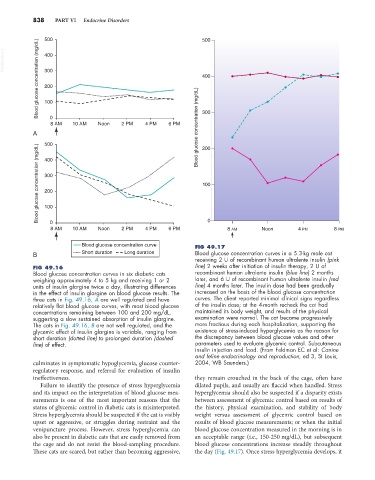Page 866 - Small Animal Internal Medicine, 6th Edition
P. 866
838 500 PART VI Endocrine Disorders 500
Blood glucose concentration (mg/dL) 300 400
VetBooks.ir 400
200
100
0
8 AM 10 AM Noon 2 PM 4 PM 6 PM Blood glucose concentration (mg/dL) 300
A 500 200
Blood glucose concentration (mg/dL) 400 100
300
200
100
0
8 AM 10 AM Noon 2 PM 4 PM 6 PM 0 8 AM Noon 4 PM 8 PM
Blood glucose concentration curve FIG 49.17
B Short duration Long duration Blood glucose concentration curves in a 5.3-kg male cat
receiving 2 U of recombinant human ultralente insulin (pink
FIG 49.16 line) 2 weeks after initiation of insulin therapy, 2 U of
Blood glucose concentration curves in six diabetic cats recombinant human ultralente insulin (blue line) 2 months
weighing approximately 4 to 5 kg and receiving 1 or 2 later, and 6 U of recombinant human ultralente insulin (red
units of insulin glargine twice a day, illustrating differences line) 4 months later. The insulin dose had been gradually
in the effect of insulin glargine on blood glucose results. The increased on the basis of the blood glucose concentration
three cats in Fig. 49.16, A are well regulated and have curves. The client reported minimal clinical signs regardless
relatively flat blood glucose curves, with most blood glucose of the insulin dose; at the 4-month recheck the cat had
concentrations remaining between 100 and 200 mg/dL, maintained its body weight, and results of the physical
suggesting a slow sustained absorption of insulin glargine. examination were normal. The cat became progressively
The cats in Fig. 49.16, B are not well regulated, and the more fractious during each hospitalization, supporting the
glycemic effect of insulin glargine is variable, ranging from existence of stress-induced hyperglycemia as the reason for
short duration (dotted line) to prolonged duration (dashed the discrepancy between blood glucose values and other
line) of effect. parameters used to evaluate glycemic control. Subcutaneous
insulin injection and food. (From Feldman EC et al: Canine
and feline endocrinology and reproduction, ed 3, St Louis,
culminates in symptomatic hypoglycemia, glucose counter- 2004, WB Saunders.)
regulatory response, and referral for evaluation of insulin
ineffectiveness. they remain crouched in the back of the cage, often have
Failure to identify the presence of stress hyperglycemia dilated pupils, and usually are flaccid when handled. Stress
and its impact on the interpretation of blood glucose mea- hyperglycemia should also be suspected if a disparity exists
surements is one of the most important reasons that the between assessment of glycemic control based on results of
status of glycemic control in diabetic cats is misinterpreted. the history, physical examination, and stability of body
Stress hyperglycemia should be suspected if the cat is visibly weight versus assessment of glycemic control based on
upset or aggressive, or struggles during restraint and the results of blood glucose measurements; or when the initial
venipuncture process. However, stress hyperglycemia can blood glucose concentration measured in the morning is in
also be present in diabetic cats that are easily removed from an acceptable range (i.e., 150-250 mg/dL), but subsequent
the cage and do not resist the blood-sampling procedure. blood glucose concentrations increase steadily throughout
These cats are scared, but rather than becoming aggressive, the day (Fig. 49.17). Once stress hyperglycemia develops, it

